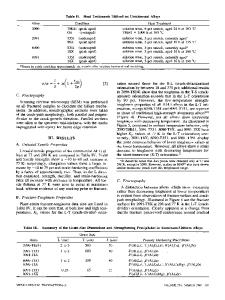Evidence of shear ligament toughening in TiAl-base alloys
- PDF / 3,594,188 Bytes
- 12 Pages / 613 x 788.28 pts Page_size
- 58 Downloads / 406 Views
I.
INTRODUCTION
IT is commonly observed that TiAl-base alloys heattreated to a predominantly lamellar microstructure are generally more resistant to fracture than those with either the equiaxed gamma or duplex microstructure.tl-lq Recent work has revealed that fracture resistance in lamellar TiAl-base alloys is the consequence of the formation of noncoplanar microcracks ahead of the crack tip, resuiting in intact ligaments between the main crack and the microcracks. It'5,6,9,1~ The microcracks are usually nucleated by decohesion of a2/3' interfaces and deformation (slip or microtwin) planes, tl61 Interaction of the main crack with the noncoplanar microcracks often resuits in a shear mode of cracking in the ligaments. These ligaments act to hinder the crack surface opening and must be deformed and fractured before further extension of the main crack can proceed. Redundant deformation and fracture in the ligaments leads to an enhancement in the crack-growth toughness that is manifested as a resistance-curve effect, tm3] This form of toughening by crack-wake ligaments in lamellar TiAl-base alloys has been modeled [~'13j and referred to as shear ligament toughening because the ligaments usually fail by shear.lJJ While many aspects of the ligament-toughening process have been established qualitatively, this extrinsic toughening mechanism remains unproven from the viewpoint that a quantitative comparison of model calculation and experimental result of fracture toughness has not been made. Additionally, the role of microstructural size in the fracture process and ligament toughening has not been fully established. A previous study has shown that the fracture toughness of TiAl-base alloys depends on colony or grain size in a complex manner, especially for the lamellar alloys that have relatively large colonies (>600 /zm). I61 A follow-up study[141 has indicated that the complex dependence of fracture toughness on colony size originates from a variation in the lamellae spacing that has occurred when the colony size is altered by heat treatment.
The fracture toughness values of two lamellar TiA1base alloys, Ti-47A1-2.6Nb-lCr-lV and Ti-47A12.3Nb-1.6Cr-0.9V (all compositions are reported in atomic percent), were found to increase with decreasing lamellar spacing t~4] in a manner similar to that described in the Hall-Petch relation, t17,'81 Both the initiation toughness (Ktc) and the crack-growth toughness, (K,), which is the asymptotic or maximum value in the K-resistance curve, were found to exhibit the Hall-Petch behavior. The former (K~c) refers to the stress intensity at the onset of stable crack growth, while the latter (Ks) refers to the stress intensity value at the onset of unstable crack growth. A similar Hall-Petch correlation between the Klc and Ks values with the colony size yielded no obvious relationship.['4] Instead, experimental observation suggested that the Hall-Petch relation was the result of the ligament size decreasing with increasing lamellae spacing. Quantitative measurement of ligament size as a fun
Data Loading...











